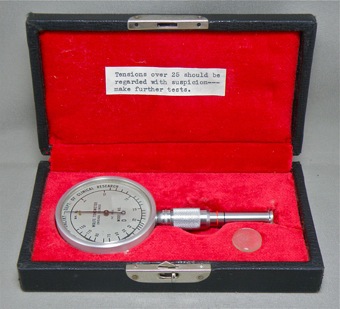Wolfe tonometer
Catalogue Number: 3160 Wolfe tonometer Category: Equipment Sub-Category: Tonometer Year Of Publication/Manufacture: c 1950 Time Period: 1940 to 1999 Place Of Publication/Manufacture: Chicago, Ill, USA Publisher/Manufacturer: Illinois College of Optometry Description Of Item: Wolfe scleral tonometer for measuring intra-ocular pressure by calibrated indentation of the sclera of the eye. It is a metal chromium plated instrument comprising a glass covered circular dial, 51 mm dia, with a metal stem 60 mm long within which is a spring loaded metal rod protruding a few millimetres from a footplate. The stem has a milled sliding collar for holding the instrument The dial has a circular scale ranging from 10 to 139 mm Hg. It is marked in the center part of the dial ' WOLFE TONOMETER / CHICAGO ILLINOIS / PAT PEND /MODEL NO / D 928 ' and around the circumference of the dial the words 'ILLINOIS COLLEGE OF OPTOMETRY DEPT. OF CLINICAL RESEARCH'. It is contained in a rectangular box, 145 x 80 x 30 mm. with a hinged lid, the interior of which is lined with red velvet shaped to hold the tonometer. There is a plastic calibration button affixed to the velvet lined interior and a label pasted on the inside the lid reading 'Tensions over 25 should be regarded as suspicion ... make further tests.' the outside of the lid is gold stamped 'WOLFE TONOMETER' and the crest of the Illinois College of Optometry. Historical Significance: Measurement of intra-ocular pressure (IOP) by calibrated indentation of the cornea was devised by Hjamar Schiotz in 1905 (The Schiotz tonometer) but it was not much used until corneal anaesthetics became available and until chronic open angle glaucoma was identified in the 1950s as a common, symptomless but insidious cause of loss of vision from moderately raised IOP. This became a much promoted as a major public health issue in the 1960s and 1970s and optometrists wanted to be able to say that they had the knowledge and techniques to diagnose it. However optometrists were prohibited from using ocular drugs by their registration acts (except in the UK) so a tonometer that could measure IOP by indenting the less sensitive sclera instead of the cornea had attraction. Scleral tonometry was never widely adopted because it was shown not to be a valid and reliable method of measuring IOP. See HAVENER WH, PATTERSON J. The Wolfe scleral tonometer. Am J Ophthalmol.1960 Feb;49:355-7; CARTER JH.The principles of tonometry and the Wolfe scleral tonometer. Part III. Am J Optom Arch Am Acad Optom. 1959 Nov;36:595-607; WOLFE OR. Wolfe corneal scleral tonometer, model B. Eye Ear Nose Throat Mon. 1950 Aug;29(8):429-31; Cockburn DM. A comparison of scleral and corneal tonometry. Br JPhysiol Optics 1958; 15: 227-235. How Acquired: Purchased by Kett Museum Date Acquired: October 2016 Condition: Fine Location: Archive room. East wall Unit 3 Cupboard |


